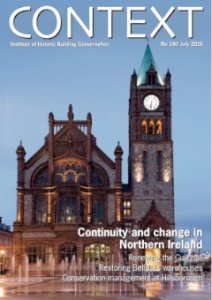The University of Leicester is involved in a UK mapping project which shows the degree of change to land cover over a six year period; from 2006 – 2012 3,000 hectares of coniferous forests were cleared for industrial development, 7,000 hectares were converted from forest to artificial surfaces, and over 14,000 hectares changed from agricultural areas to artificial surfaces.
Large-scale changes to the environment of the United Kingdom, including an apparent loss of habitats and agricultural land, have been revealed through an updated national map of land cover launched by researchers at the University of Leicester together with consultancy company Specto Natura.
The land cover map, which examines data from 2006 and 2012, is based upon a standardised classification system of 44 land cover and land use classes which are structured in a three tier system that shows how much of the UK is made up of artificial surfaces, agricultural areas, forest and semi-natural areas, wetlands and water bodies. The ‘Coordination of Information on the Environment’ (CORINE) Land Cover (CLC) map forms the central part of the European Land Monitoring Service under the Copernicus Programme. It is a European-wide project gathering together information relating to the Environment within the European Union.
Professor Heiko Balzter, Director of the Centre for Landscape and Climate Research at the University of Leicester and leader of the study, said: ‘Environmental information from satellites is hugely important to keep a check on the quality of life in the UK. The European land monitoring service turns satellite data into policy-relevant information. The CORINE map is the only consistent European information on land cover change that allows a comparison with our neighbours.’
The land cover map depicts areas larger than 25 hectares (0.25 km2) and with a width of 100m. In addition, a land cover change map between 2006 and 2012, which detects changed areas larger than 5 hectares, has been produced. Professor Balzter added: ‘For the reference year of 2012, this is the only land cover information available for the UK. At the scale of change mapping of 5 hectares or larger, there appears to be a loss of semi-natural habitats and agricultural land. The apparent decline in wetlands is particularly concerning.
‘The maps show the need for a more detailed study of the state of our countryside, because of the technical limitations of the CORINE mapping approach at a coarse spatial scale.’
Key findings from the 2006-2012 land cover map are:
- An area of 225,200 hectares (over 2,250 km2) or 1% of the total area of the UK showed a change in land cover / use from 2006 to 2012. Altogether, 167 different types of change were seen from the satellite images.
- The changes are dominated by forest management, therefore their concentration is higher in Scotland and Wales, following the distribution of managed forest.
- Forestry: The dominant change was clear-cutting of coniferous forest (over 100,000 hectares). Almost 50,000 hectares were regrowing or being replanted with coniferous forest. Clear cutting far exceeded replanting of coniferous forest, however the slow regrowth of forest is more difficult to map consistently.
- Forest loss: Nearly 3,000 hectares of coniferous forests were cleared for industrial development. Conversion of coniferous forest to industrial and mineral extraction sites largely relates to the erection of wind turbines in upland areas, mainly in Scotland. Wind farms fall into the industrial land cover class in the European system. The rate of conversion of land to sport and leisure facilities, mainly golf courses at this scale, continues to decline. Clear cutting of mixed forests accounted for another ca. 3,000 hectares.
- Urban expansion: Changes of a range of other cover types to artificial surfaces indicate urbanisation. Over 7,000 hectares were converted from forest to artificial surfaces, and over 14,000 hectares changed from agricultural areas to artificial surfaces. Over 1,000 hectares were converted from wetlands to artificial surfaces. Completion of construction sites in urban areas made up nearly 3,000 hectares and completed new industrial and commercial developments just over 1,000 hectares.
- Loss of arable land: Over 3,000 hectares of arable land and 2,000 hectares of pastures were converted to mineral extraction sites. Over 2,000 hectares of arable land and 2,000 hectares of pasture land were converted to construction sites, but nearly 2,000 hectares of mineral extraction sites were converted back to pasture land. Pasture land converted to arable land made up over 1,000 hectares. Some agricultural land was planted with forest and some changed to wetlands.
- The most dominant land cover type in the UK in 2012 remains agricultural land, followed by forest and semi-natural vegetation. Artificial surfaces represent 8% of the country with the majority being urban settlements.
In addition to the new land cover map, the previous 2006 land cover map has also been corrected by the team and updated to make sure the change results more closely reflect reality. The 2006 revision and 2006-2012 change maps were produced by visual interpretation of optical and near-infrared satellite images provided by the European Space Agency with a spatial resolution of 20m, supplemented with higher spatial resolution images with 5m pixels. The 2012 map was produced in a GIS operation adding the revised database and the change database.
Dr Beth Cole, postdoctoral researcher from the University of Leicester’s Department of Geography in charge of the map production, said: ‘The production of the 2012 CLC map and the detection of land cover change between 2006 and 2012 shows a continuing trend in the UK landscape of the rotation of clear-cutting and regrowth associated with forest management and a growth in artificial surfaces associated with urban expansion. Monitoring like this at a National and European scale is key to allow us to identify these broad landscape scale changes. With a significant improvement on the previous version of the 2006 map, as well as the 2012 update, this study provides data for a large number of users and can be fed into a wide range of research topics and applications.’
The interpretation of satellite images took two years and was carried out with funding by the European Union, supported by the Department of Environment, Food and Rural Affairs (Defra) and the European Environment Agency (EEA).
The CORINE land cover maps have many real-world applications. As a freely available dataset they can be used in any agency or business. Examples of previous uses include land management, insurance companies, planning regulations, population disaggregation, forest mapping, green infrastructure, land fragmentation assessment, studies of the urban heat island effect and flood risk mapping. The maps have informed environmental policy in the fields of climate change, nature conservation and biodiversity, natural resources, environmental health and quality of life. They have also found uses in research of biodiversity, crop yield monitoring, ecosystem services, the water cycle, urban sprawl and wildfire management.
View the news release
IHBC newsblogs on natural landscape issues



